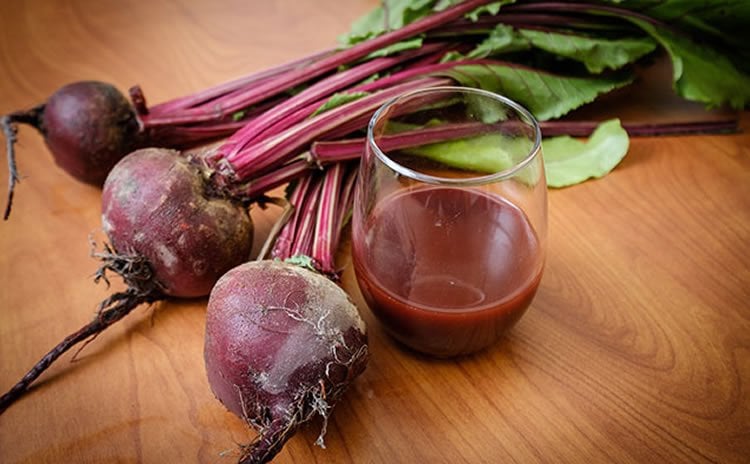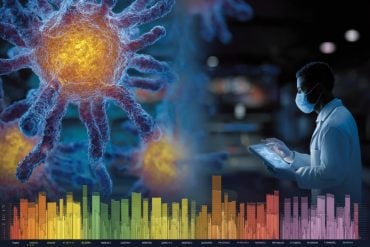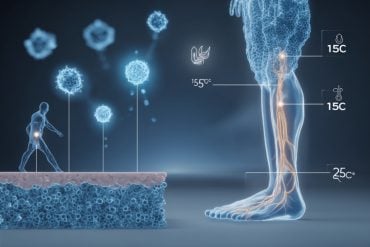Summary: Researchers say drinking beetroot juice prior to exercise can help the aging brain to perform more efficiently.
Source: Wake Forest University.
Drinking a beetroot juice supplement before working out makes the brain of older adults perform more efficiently, mirroring the operations of a younger brain, according to a new study by scientists at Wake Forest University.
“We knew, going in, that a number of studies had shown that exercise has positive effects on the brain,” said W. Jack Rejeski, study co-author. “But what we showed in this brief training study of hypertensive older adults was that, as compared to exercise alone, adding a beet root juice supplement to exercise resulted in brain connectivity that closely resembles what you see in younger adults.”
While continued work in this area is needed to replicate and extend these exciting findings, they do suggest that what we eat as we age could be critically important to the maintenance of our brain health and functional independence.
Rejeski is Thurman D. Kitchin Professor and Director of the Behavioral Medicine Laboratory in the Department of Health & Exercise Science. The study, “Beet Root Juice: An Ergogenic Aid for Exercise and the Aging Brain,” was published in the peer-reviewed Journals of Gerontology: Medical Sciences. One of his former undergraduate students, Meredith Petrie, was the lead author on the paper.
This is the first experiment to test the combined effects of exercise and beetroot juice on functional brain networks in the motor cortex and secondary connections between the motor cortex and the insula, which support mobility, Rejeski said.
The study included 26 men and women age 55 and older who did not exercise, had high blood pressure, and took no more than two medications for high blood pressure. Three times a week for six weeks, they drank a beetroot juice supplement called Beet-It Sport Shot one hour before a moderately intense, 50-minute walk on a treadmill. Half the participants received Beet-It containing 560 mg of nitrate; the others received a placebo Beet-It with very little nitrate.
Beets contain a high level of dietary nitrate, which is converted to nitrite and then nitric oxide (NO) when consumed. NO increases blood flow in the body, and multiple studies have shown it can improve exercise performance in people of various ages.
“Nitric oxide is a really powerful molecule. It goes to the areas of the body which are hypoxic, or needing oxygen, and the brain is a heavy feeder of oxygen in your body,” said Rejeski.

When you exercise, the brain’s somatomotor cortex, which processes information from the muscles, sorts out the cues coming in from the body. Exercise should strengthen the somatomotor cortex.
So, combining beetroot juice with exercise delivers even more oxygen to the brain and creates an excellent environment for strengthening the somatomotor cortex. Post-exercise analysis showed that, although the study groups has similar levels of nitrate and nitrite in the blood before drinking the juice, the beetroot juice group had much higher levels of nitrate and nitrite than the placebo group after exercise.
Funding: The study was supported by the Translational Science Center of Wake Forest and received funding from the National Institutes of Health.
The research team included Paul J. Laurienti and Jonathan H. Burdette of the Department of Radiology; Anthony P. Marsh of the Department of Health & Exercise Science; Swati Basu and Daniel B. Kim-Shapiro of the Department of Physics; and James L. Norris of the Department of Mathematics.
Source: Katie Neal – Wake Forest University
Image Source: NeuroscienceNews.com image is credited to WFU/Ken Bennett.
Original Research: Abstract for “Beet Root Juice: An Ergogenic Aid for Exercise and the Aging Brain” by Meredith Petrie, W. Jack Rejeski, Swati Basu, Paul J. Laurienti, Anthony P. Marsh, James L. Norris, Daniel B. Kim-Shapiro, and Jonathan H. Burdette in Journals of Gerontology: Medical Sciences. Published online November 9 2016 doi:10.1093/gerona/glw219
[cbtabs][cbtab title=”MLA”]Wake Forest University “Beet This: Beetroot Juice Before Exercise Helps Older Brains Perform More Efficiently.” NeuroscienceNews. NeuroscienceNews, 19 April 2017.
<https://neurosciencenews.com/aging-beetroot-exercise-6445/>.[/cbtab][cbtab title=”APA”]Wake Forest University (2017, April 19). Beet This: Beetroot Juice Before Exercise Helps Older Brains Perform More Efficiently. NeuroscienceNew. Retrieved April 19, 2017 from https://neurosciencenews.com/aging-beetroot-exercise-6445/[/cbtab][cbtab title=”Chicago”]Wake Forest University “Beet This: Beetroot Juice Before Exercise Helps Older Brains Perform More Efficiently.” https://neurosciencenews.com/aging-beetroot-exercise-6445/ (accessed April 19, 2017).[/cbtab][/cbtabs]
Abstract
Beet Root Juice: An Ergogenic Aid for Exercise and the Aging Brain
Background:
Exercise has positive neuroplastic effects on the aging brain. It has also been shown that ingestion of beet root juice (BRJ) increases blood flow to the brain and enhances exercise performance. Here, we examined whether there are synergistic effects of BRJ and exercise on neuroplasticity in the aging brain.
Methods:
Peak metabolic equivalent (MET) capacity and resting-state magnetic resonance imaging functional brain network organization are reported on 26 older (mean age = 65.4 years) participants randomly assigned to 6 weeks of exercise + BRJ or exercise + placebo.
Results:
Somatomotor community structure consistency was significantly enhanced in the exercise + BRJ group following the intervention (MBRJ = −2.27, SE = 0.145, MPlacebo = −2.89, SE = 0.156, p = .007). Differences in second-order connections between the somatomotor cortex and insular cortex were also significant; the exercise + BRJ group (M = 3.28, SE = 0.167) had a significantly lower number of connections than exercise + placebo (M = 3.91, SE = 0.18, p = .017) following the intervention. Evaluation of peak MET capacity revealed a trend for the exercise + BRJ group to have higher MET capacity following the intervention.
Conclusions:
Older adults who exercised and consumed BRJ demonstrated greater consistency within the motor community and fewer secondary connections with the insular cortex compared with those who exercised without BRJ. The exercise + BRJ group had brain networks that more closely resembled those of younger adults, showing the potential enhanced neuroplasticity conferred by combining exercise and BRJ consumption.
“Beet Root Juice: An Ergogenic Aid for Exercise and the Aging Brain” by Meredith Petrie, W. Jack Rejeski, Swati Basu, Paul J. Laurienti, Anthony P. Marsh, James L. Norris, Daniel B. Kim-Shapiro, and Jonathan H. Burdette in Journals of Gerontology: Medical Sciences. Published online November 9 2016 doi:10.1093/gerona/glw219






